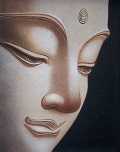- This topic has 1 reply, 2 voices, and was last updated 8 months ago by
Lal.
-
AuthorPosts
-
-
March 31, 2025 at 11:59 pm #53981
lotus
Participant1. In the “Sandha Sutta (AN 11.9)“, when asked, “How does an Ariya meditate?” the response is: “They don’t meditate (with the mind focused on) what is seen, heard, thought, known, attained, sought, or explored by the mind.”
A puthujjana does not understand distorted saññā and perceives things incorrectly due to wrong views. This makes it understandable that why a Sotāpanna Anugāmi would start to practice Satipaṭṭhāna.
Then, how does an Ariya meditate?2. An Arahant has a purified mind and does not generate javana citta. Thus, it can be inferred that they do not engage in actions that lead to individual rebirth or collective actions that contribute to shaping the environment.
If that is the case, in situations like wildfires, earthquakes, or military dictatorships where many people suffer, does an Arahant remain completely unresponsive, without any thoughts or actions?
-
April 1, 2025 at 6:23 am #53984
Lal
Keymaster1. I have linked to the place (in your comment) where the Buddha tells Sandha, “Sandha, for a fine thoroughbred person, the perception of earth has vanished in relation to earth. The perception of water … fire … air has vanished in relation to air. The perception of the dimension of infinite space has vanished in relation to the dimension of infinite space…”
- That is a critical point to understand.
- A Noble Person (Ariya) does not meditate with the focus on a worldly object like breath, a ball of clay, a water bowl, etc., as is done by anariya yogis.
- For that, an Ariya must release the mind from any “perception (saññā) about the world” because they are all “distorted saññā.”
In another thread, I listed the steps needed to get the mind off of “distorted saññā.” They are:
- It is necessary to understand the “purana kamma” and “nava kamma” stages because the “distorted saññā” arises AUTOMATICALLY in the “purana kamma” stage.
- The “purana kamma” stage happens automatically due to unbroken samyojana. the mind goes through this stage in a split second.
- The “nava kamma” stage is where we have free will to control our thoughts, speech, and actions.
- We have to start the “cleansing process” in the “nava kamma” stage and gradually take the mind toward the “purana kamma” stage.
- At the same time, one must learn the the details of the “purana kamma” and “nava kamma” stages. That means learning about “distorted sanna“, Paticca Samuppada, etc.
- At some point in this process, one will become a Sotapanna Anugami, and the mind will get the ability to bypass the “purana kamma” stage and move into the “Satipaṭṭhāna Bhumi, ” allowing the mind to be free of the “distorted sanna.” Here, one can contemplate Dhamma concepts without being hindered by the “distorted sanna.“
- That is when one becomes a Sotapanna by breaking three of the ten samyojana.
- Once becoming a Sotapanna, one must make the effort to get into the “Satipaṭṭhāna Bhumi ” as often as possible. “Satipaṭṭhāna Bhumi ” is where one can engage in Satipaṭṭhāna effectively and start breaking the remaining seven samyojana
- Once all ten samyojana are eliminated, the “nava kamma” stage will not be initiated based on ANY sensory input.
- The basic process is in the chart in #1 of “Pāth to Nibbāna – Learning Dhamma to Become a Sotapanna.”
I discussed the “Sandha Sutta” in “Sammā Samādhi – How to Define It?.”
___________
2. An Arahant is not bothered by any situations like wildfires, earthquakes, etc.
- They have been freed from suffering, except for the suffering associated with the physical body they are born with.
- They know that ALL suffering will end upon the death of the physical body and look forward to that event.
- They live only for the benefit of others, i.e., to teach Dhamma to others.
- That is why a few Arahants who had come down with terminal illnesses committed suicide (and the Buddha approved it).
-
-
AuthorPosts
- You must be logged in to reply to this topic.
